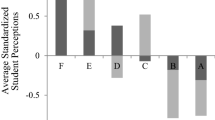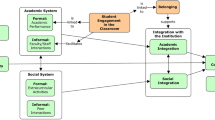This paper reports results of intensive field work in urban high school mathematics and science classrooms based on research with students attending eight high schools located in large, disparate urban sites across the U.S. During the course of our observations and interviews we recorded students’ activities as well as their impressions of classroom processes over the course of a week in each classroom using the Experience Sampling Method (ESM). ESM allows students to record information about their classroom experiences at intervals during daily mathematics and science classroom lessons. We measured levels of student engagement and examined relationships between student engagement and an array of predictors. We take a social organizational approach to interpreting classroom processes, examining the extent to which classroom activities influence student perception of class and communication among students and how these intervening factors affect student engagement during on-going classroom activities. Results suggest that there is variation between group members’ reactions to classroom activities. Specifically, as an example, Latino Students in Chicago, Miami and El Paso were far more engaged and responsive to classroom lessons during the time they spent in small problem-solving groups during class. Student Engagement in High School Mathematics and Science.


Similar content being viewed by others
References
Ainley, M., S. Hidi, D. Berndorf (2002) Interest, learning, and the psychological processes that mediate their relationship. Journal of Educational Psychology 2002:3
Barr, R., R. Dreeben (1983) How Schools Work. University of Chicago Press, Chicago
Bernstein, B. (1977) Social class, language, and socialization. In: J. Karabel, Halsey A. H. (eds), Power and ideology in education. Oxford, New York
Bidwell, C. E., J. D. Kasarda (1980) Conceptualizing and measuring the effects of school and schooling. American Journal of Education 88:401–430
Borman, K. M., & Baber M. Y. (Eds.). (1998). Ethnic diversity in communities and schools: Recognizing and building on strengths. Stamford, CT: Ablex Publishing Corporation
Bossert, S. T. (1979) Tasks and social relationships in classrooms. Cambridge University Press, Cambridge
Bourdieu, P. (1984) Distinction: A social critique of the judgement of taste. Harvard University Press, Cambridge
Boykin, A. W. (1978) Psychological/behavioral verve in academic/task performance: Pre-theoretical considerations. Journal of Negro Education 47:343–345
Coleman, J. S., E. Q. Campbell, C.J. Hobson, J. McPartland, A. J. Mood, F. D. Weinfeld, R. L. York (1966) Equality of Educational Opportunity. USGPO, Washington, D.C.
Csikszentmihalyi, M. (1990) Flow the psychology of optimal experience. Harper and Row, New York
Csikszentmihalyi, M., R. Larson (1989) Being Adolescent: Conflict and growth in the teenage years. Basic Books, New York
Csikszentmihalyi, M., B. Schneider (eds) (2000) Becoming adult: How teenagers prepare for the world of work. Basic Books, New York
Downey, D. B., S. Pribesh (2004) When race matters: teachers’ evaluations of students’ classroom behavior. Sociology of Education 77:267–282
Evans, F.B., J. G. Anderson (1973) The psychocultural origins of achievement and achievement motivation: The Mexican American family. Sociology of Education 46:396–416
Felmlee, D., D. Eder (1983) Contextual effects in the classroom: The impact of ability groups on student attention. Sociology of Education 56:77–87
Felmlee, D., D. Eder, W.-Y. Tsui (1985) Peer influence on classroom attention. Social Psychology Quarterly 48:215–226
Finn, J. D., & Cox, D. (1992). Participation and withdrawal among fourth-grade pupils. American Educational Research Journal, 29:141–162
Finn, J. D, K. E. Voelkl (1993) School characteristics related to student engagement. Journal of Negro Education 62:249–268
Fordham, S., J. U. Ogbu (1986) Black students’ school success: Coping with the burden of ’acting Whites’. Urban Review 18:176–206
Gamoran, A., M. Nystrand (1992) Taking students seriously. In: Fred M. N. (eds), Student engagement and achievement in american secondary schools. Teachers College Press, New York, pp 40–61
Genova, W. J. et al. (1981). A study of interaction effects of school and home environments on students of varying race/ethnicity, class, and gender. Final report. Volume I: Summary and conclusions. Massachusetts: TDR Associates Inc., Newton MA.
Hedges, L. V, A. Nowell (1999) Changes in the Black–White gap in achievement test scores. Sociology of Education 72:111–135
Hiebert, J., Gallimore R., Garnier H., K. B. Giwin, Hollingsworth H., Jacobs J., Chui M. Y., Wearne D., Smith M., Kersting N., Manaster A., Tseng E., Etterbeek W., Manaster C., Gonzales P., Stigler J. (2000) Highlights from the TIMSS 1999 video study of eighth-grade mathematics teaching. National Center for Education Statistics, Washington DC
Hiebert, J., R. Gallimore, H. Garnier, K. B. Giwin, H. Hollingworth, J. Jacobs, A. M.-Y. Chui, D. Wearne, M. Smith, N. Kersting, A. Manaster, E. Tseng, W. Etterbeek, C. Manaster, P. Gonzales, J. Stigler (2003) Teaching mathematics in seven countries. National Center for Educational Statistics, Washington DC
Imai, M., R. C. Anderson, I. A. G. Wilkinson, H. Yi (1992) Properties of attention during reading lessons. Journal of Educational Psychology 84:160–173
Linacre, J. (2006) Winsteps. Winsteps, Chicago
Laosa, L. M. (1973). Reform in educational and psychological assessment: Cultural and linguistics issues. Journal of the Association of Mexican-American Education, 1, 19–24.
Larson, R., & Csikszentmihalyi, M. (1983) The experience sampling method. In H. G. Reis (Eds.), Naturalistic approaches to studying social instruction (pp. 42–56). Jossey-Bass, San Francisco
Lee Valerie, E., & Smith, J. B. (1993) Effects of school restructuring on the achievment and engagement of middle-grade students. Sociology of Education, 66, 164–187
Marks, H. M. (2000) Student engagement in instructional activity: Patterns in the elementary, middle, and high school years. American Educational Research Journal, 37, 153–184
McFarland, D. A. (2001) Student resistance: How the formal and informal organization of classrooms facilitate everyday forms of student defiance. American Journal of Sociology, 107, 612–678
Mehan, H. (1984) Language and schooling. Sociology of Education, 57, 174–183
Mehan, H. (1992) Understanding inequality in schools: The contribution of interpretative studies. Sociology of Education, 65, 1–20
Moll, L. C. (1992) Funds of knowledges for teaching: Using a qualitative approach to connect homes and classrooms. Theory into Practice, 31, 132–141
Nakamura, J., & Csikszentmihalyi, M. (2002) The concept of flow. In C. R. Snyder, & S. J. Lopez S. J. (Eds.), Handbook of positive psychology (pp. 89–105). New York: Oxford University Press
NCTM. (1991). Professional standards for school mathematics. Reston, VA: Authors
NCTM. (2000). Principles and standards for school mathematics. Reston, VA: Authors
Newmann, F. M. (Eds.) (1992) Student engagement and achievement in American secondary schools. New York: Teachers College Press
Nystrand, M., & Gamoran, A. (1991) Instructional discourse, student engagement, and literature achievement. Research in the Teaching of English, 25, 261–290
Nystrand, M., Wu, L. L., Gamaron, A., Zeiser, S., & Long, D. (2001) Questions in time: Investigating the structure and dynamics of unfolding classroom discourse. Albany: National Research Center on English Learning & Achievement
Oakes, J. (1985) Keeping track. New Haven: Yale University Press
Page, R. N. (1991) Lower track classrooms: A curricular and cultural perspective. New York: Teachers College Press
Philips, S. (1972) The invisible culture: communication in classroom and community on the warm springs Indian reservation. Longman, New York
Raudenbush, S., Bryk A. S. (2002) Hierarchical linear models: Applications and data analysis methods. Sage Publications, Newbury Park
Rosenbaum, J. E. (1976) Making inequality. Wiley, New York
Shneider, B., Lee Y. (1990) A model for academic success: The school and home environment of East Asian students. Anthropology & Education Quarterly 21–4:358–377
Shernoff, D. (2001). The experience of student engagement in high school classrooms: A phenomenological perspective. Chicago: Department of Education, The University of Chicago
Shernoff, D. J., Csikszentmihalyi M., Schneider B., Shernoff E.S. (2003) Student engagement in high school classrooms from the perspective of flow theory. School Psychology Quarterly 18:158–176
Shernoff, D., Knauth S., Makris E. (2000) The Quality of Classroom Experiences. In: M. Csikszentmihalyi, B. Schneider (eds), Becoming adult. Basic Books, New York, pp 141–164
Stigler, J. W, Hierbert J. (1999) The teaching gap: Best ideas from the world’s teachers for improving education in the classroom. The Free Press, New York
Temkin, J. (2004). Student engagement varies by race and type of instruction. Catalyst Chicago
Turner, J. C., Meyer D. K., Cox K. E., Logan C., DiCinto M., Thomas C. T. (1998) Creating contexts for involvement in mathematics. Journal of Educational Psychology 90:730–745
Wong, K. K, Lee J. (1998) Interstate variation in the achievement gap among racial and social groups: Considering the effects of school resources and classroom practices. Advances in Educational Policy 4:119–142
Wortham, S., Contreras M. (2002) Struggling toward culturally relevant pedagogy in the latino diaspora. Journal of Latinos and Education 1:133–44
Wright, B. D., Masters G. (1982) Rating scale analysis. MESA Press, Chicago
Wright, B. D., Stone M. (1979) Best test design. MESA Press, Chicago
Yair, G. (2000) Educational battlefields in America: The tug of war over students’ engagement with instruction. Sociology of Education 73:247–269
Acknowledgements
This research is supported by a grant from National Science Foundation #9874246 awarded to the second author. Opinions reflect those of the authors and do not necessarily reflect those of the granting agency. We acknowledge the support of Ginger Baber, Ted Boydston, Tim Carey, Bridget Cotner, Bill Katzenmeyer, Jeff Kromrey, and Gladis Kersaint, as well as other staff at David C. Anchin Center at the University of South Florida. We also acknowledge the advice of Charles Bidwell, John Ferron, Makoto Hogetsu, John Linacre, Jennifer Schmidt, David Shernoff and Benjamin Wright. The first author was supported during the write-up of this paper by the Japan Society for the Promotion of Science.
Author information
Authors and Affiliations
Additional information
Kazuaki Uekawa is affiliated with the American Institutes for Research, Washinton DC, USA. Kathryn Borman and Reginald Lee are affilated with the The University of South Florida, Tampa, FL, USA. Address correspondence to Kazuaki Uekawa, American Institutes for Research, Washinton DC, USA; e-mail: kuekawa@air.org
Appendix
Appendix

Rights and permissions
About this article
Cite this article
Uekawa, K., Borman, K. & Lee, R. Student Engagement in U.S. Urban High School Mathematics and Science Classrooms: Findings on Social Organization, Race, and Ethnicity. Urban Rev 39, 1–43 (2007). https://doi.org/10.1007/s11256-006-0039-1
Published:
Issue Date:
DOI: https://doi.org/10.1007/s11256-006-0039-1




